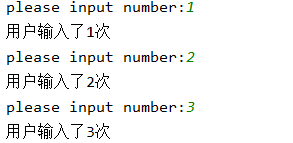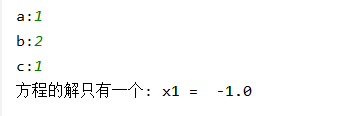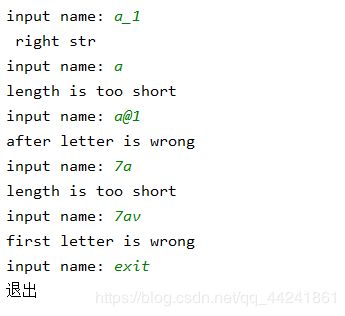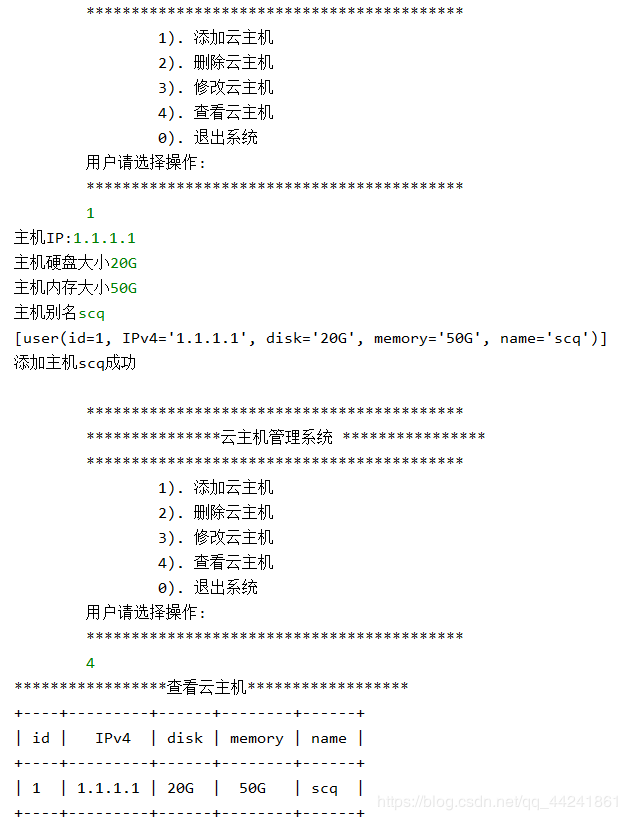python基础题
文章目录
- for 、if-else、while、应用
- 字符串、列表与元组应用
for 、if-else、while、应用
一:求1-100偶数和
sum=0 #0+2+4... 从0开始
for i in range(1,101):
if i%2==0:
sum+=i
print(sum)try_count=0 #循环未开始,count=0
while try_count < 3 :
num=input('please input number:')
try_count +=1 #用户输入一次,count加一,count计数完显示用户输入的次数
print('用户输入了%d次' %(try_count))import random
year=random.randint(1900,2000)
if (year % 4 == 0 and year % 100 != 0) or (year % 400 == 0):
print(year,'is 闰年')
else:
print(year,'is not 闰年')
'''
九九乘法表中,第一行一列,第二行2列...第九行9列
每一行都固定相应的列,用嵌套循环取值
i=1 j=1
i=2 j=1,2
i=3 j=1,2,3
i=4 j=1,2,3,4
i=5 j=1,2,3,4,5
i=6 j=1,2,3,4,5,6 #j从1开始到i结束
#循环一次不换行打印一行,打印完一行后换行(i先遍历第一个值,j遍历完1-i个值再换行,接着i去遍历下一个值) 下三角
for i in range (1,10)
for j in range (1,i+1)
print('%d*%d=%d'%(j,i,j*i),end='')
print()
'''
#打印上三角
for i in range (9,0,-1):
for j in range (1,i+1):
print('%d*%d=%d'%(j,i,j*i),end='')
print()
a=int(input('a:'))
print('%d is even'%(a) if a%2==0 else '%d is odd'%(a))import math
a=int(input('a:'))
b=int(input('b:'))
c=int(input('c:'))
s=b**2-4*a*c
if s==0:
print('方程的解只有一个: x1 = ',(-1*b)/(2*a))
elif s>0 :
x1=((-1*b)+math.sqrt(s))/(2*a)
x2=((-1*b)-math.sqrt(s))/(2*a)
print('方程的解为:%.3f 和 %.3f'%(x1,x2))
else:
print('方程无解')count=0
while count < 3:
count+=1
print('第%d次登陆:'%(count))
name=input('name:')
passwd=input('passwd:')
if name=='root':
if passwd=='redhat':
print('%s登陆成功'%(name))
break
else:
print('%s登陆失败,密码不正确' % (name))
else:
print('身份不正确')
else:
print('超过登陆次数')
字符串、列表与元组应用
一:编写一个检查 Python 有效标识符的小脚本,名字是 idcheck.py。
要求:Python 标识符必须以字母或下划线开头
1). 只检查长度大于等于 2 的标识符
2). 以字母或者下划线开始
3). 后面要跟字母,下划线或者或数字
while True :
import string
name=input('input name: ')
if name=='exit':
print('退出')
exit(0)
if len(name) > 2 :
if name[0] in string.ascii_letters+'_':
for i in name[1:]:
#遍历一个letter检测一遍,只要检测到错误的letter就退出,因此只显示一遍letter is wrong就退出,如果全部正确,只显示一遍正确str。如果if下条件为判断正确,由于i遍历name,因此会一直print
if not ( i in string.digits+string.ascii_letters+'_'):
print('after letter is wrong')
break
#else对应for,表示for遍历结束后执行的语句。
else:
print(' right str')
else:
print('first letter is wrong')
else:
print('length is too short')- 只考虑字母或者数字字符: 删除非字母或数字
- 忽略字母的大小写: 统一转成大写或者小写
##忽略大小写:统一转换成大写或者小写
#转换成小写: 字符.lower()
##只考虑字母或者数字:删除非字母数字的字符
string1=input('string: ')
string2=''
for item in string1:
if item.isalnum():
string2+=item
string3=string2.lower()
print(string3==string3[::-1]) 效果:

三:打印/var/log/目录中所有的日志文件名称(以.log结尾)
import os
filename=os.listdir('/var/log')#列出/var/log内所有文件名组成列表存入filename中
for item in filename:
if item.endswith('.log'):#判断文件名是否以.log结尾
print(item)
#url='hello'
#url.startswith('hel') 判断url是否以hel为开头,返回值为True四:编写一个函数来验证输入的字符串是否是有效的 IPv4 ?
1). IPv4 地址由十进制数和点来表示,每个地址包含4个十进制数,其范围为 0 - 255, 用(".")分割。
比如,172.16.253.1;
2). IPv4 地址内的数不会以 0 开头。比如,地址 172.16.254.01 是不合法的
#ip = ‘172.25.254.100’
ip=input('ip: ')
ip1=ip.split('.')
if len(ip1)==4:
for item in ip1:
if not(0 <= int(item) <= 255):
print('too long')
break
if len(item)>1 and item.startswith('0'):
print('error: has 0')
break
else:
print('ok')
else:
print('error')
'''
写法:
1:先满足大条件下:长度为4
在大条件下写满足的小条件
2:一旦监测到错误就退出,检测正确后面也有可能是错误的没有监测到,无法下结论,因此用反向思维,而且print也只要求打印一遍。
'''word=input('input a word: ')
if word.isupper() or word.istitle() or word.islower():
print('correct')
else:
print('wrong')moves=input('>>')
print(moves.count('l')==moves.count('r') and moves.count('u')==moves.count('o'))
'''
用户输入lruo,只要向左向右向上向下次数相同,就会返回原点,代码意义上为:输入字符串中的字母次数相同即可
'''a=input('>>')
print(a.count('A')<=1 and a.count('LLL')<1)
'''
不超过2个连续的LL('LL'出现只有一个,不可以连续出现):LL<=1的话LLL也表示连续的LL不超过2个,LLL中的LL只有1个
'LLL')<1表示LLL以及LLLL...出现都为False,LL、L均为True。LL、L可以满足条件。
'''效果:

八:设计一个程序,用来实现帮助小学生进行算术运算练习,它具有以下功能:提供基本算术运算
(加减乘)的题目,每道题中的操作数是随机产生的,练习者根据显示的题目输入自己的答案,程
序自动判断输入的答案是否正确并显示出相应的信息。最后显示正确率。
思路:
l 运行程序, 输入测试数字的大小范围
l 输入测试题目数量
l 任意键进入测试
l 系统进行测试并判断对错
l 系统根据得分情况进行总结,退出程序
步骤:
l 显示输入测试题数字的大小范围
l 显示输入测试题目数量
l 显示任意键进入测试
l 系统对用户输入的三个值分析如果均为空,使用默认值,否则转为int型
l 随机生成两个在用户给定范围的值,以及对两个值进行运算的操作符
l 用户输入答案
l 系统求解
l 系统检测并判断对错
l 系统根据正确个数百分比显示正确率,退出程序
l 根据用户输入的题目数量值count对系统出题次数进行循环
l 用户每做对一道题记录一次,用于求正确率
start=’’
bool(start)=False
if 后返回bool值
if not start #表示start为空时用默认值0
start=0
import random
start = input('输入测试数字的开始范围,默认为0>>')
end = input('输入测试数字的结束范围,默认为10>>')
count = input('输入测试题目数量,默认为10>>')
input('******任意键进入测试****')
start=0 if not start else int(start)
end=10 if not end else int(end)
count=10 if not count else int(count)
right_count=0
for item in range(count) :#出题数量
num1=random.randint(start,end) #随机生成题目数字并限定出题数字范围
num2=random.randint(start,end)
operator=random.choice('+-*')
usr_result=int(input('%s %s %s ='%(num1,operator,num2))) #用户答案转为int才可以与系统求解值check(int型)比较
check=eval('%s%s%s'%(num1,operator,num2)) #check为int型
if usr_result==check:
print('correct')
right_count+=1
else:
print('wrong')
print('正确率为%.2f %%'%((right_count/count)*100))效果:
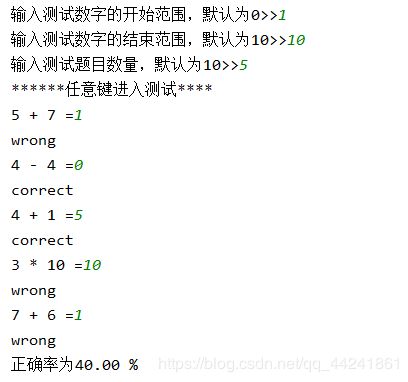
九:建立一个命名元组
#命名元组:给里面的元素起名
collections.namedtuple(typename, field_names)
typename:类名称
field_names: 元组中元素的名称
from collections import namedtuple
user=namedtuple('user','name passwd')#定义名称为user,元素为name passwd
#user=namedtuple('user',['name','passwd'])#定义元素的2种方法:列表或字符串,定义名称为user,元素为name passwd
user1=user('scq','redhat') #给name passwd 传真实数据
print(user1.name,user1.passwd,user1)效果:

十: 设置云主机系统
云主机的属性信息:
id: 递增,主机id
IPv4: 主机IP
disk: 主机硬盘大小
memory: 主机内存大小
name: 主机别名
from collections import namedtuple
from prettytable import PrettyTable
promt="""
******************************************
***************云主机管理系统 ****************
******************************************
1). 添加云主机
2). 删除云主机
3). 修改云主机
4). 查看云主机
0). 退出系统
用户请选择操作:
******************************************
"""
id=0
information1=[]
user=namedtuple('user',['id','IPv4','disk','memory','name']) #定一个名为user的命名元组
while True:
choice=input(promt)
if choice == '1':
id+=1 #id自动加一当作用户的id
IPv4=input('主机IP:')
disk=input('主机硬盘大小')
memory=input('主机内存大小')
name=input('主机别名')
user1=user(id,IPv4,disk,memory,name)#给命名元组传入参数,user1形式为user(id=1, IPv4='1', disk='1', memory='1', name='1')
information1.append(user1)#,将元组追加到列表中,作为列表的一项
print(information1) #存入形式为:[user(id=1, IPv4='1', disk='1', memory='1', name='1')]
print("添加主机%s成功" %(name))
elif choice == '2':
print("删除云主机".center(40, '*'))
dele_id=int(input('输入要删除的ip:'))
for host in information1:#查找信息,让host=列表中的元组
if dele_id==host.id : #用户输入的id与命名元组中的id匹配时
information1.remove(host)#删除信息中的一个元组,元组存储一个用户的所有信息
print('%d删除成功'%(dele_id))
break
else:
print('没有找到指定ip')
elif choice=='3':
pass
elif choice=='4':
print("查看云主机".center(40, '*'))
table=PrettyTable(field_names=['id','IPv4','disk','memory','name'])
for i in information1:
table.add_row(i) #按行存入信息到表中
print(table)
elif choice=='0':
exit(0)
else:
print('请输入正确的数字:')
